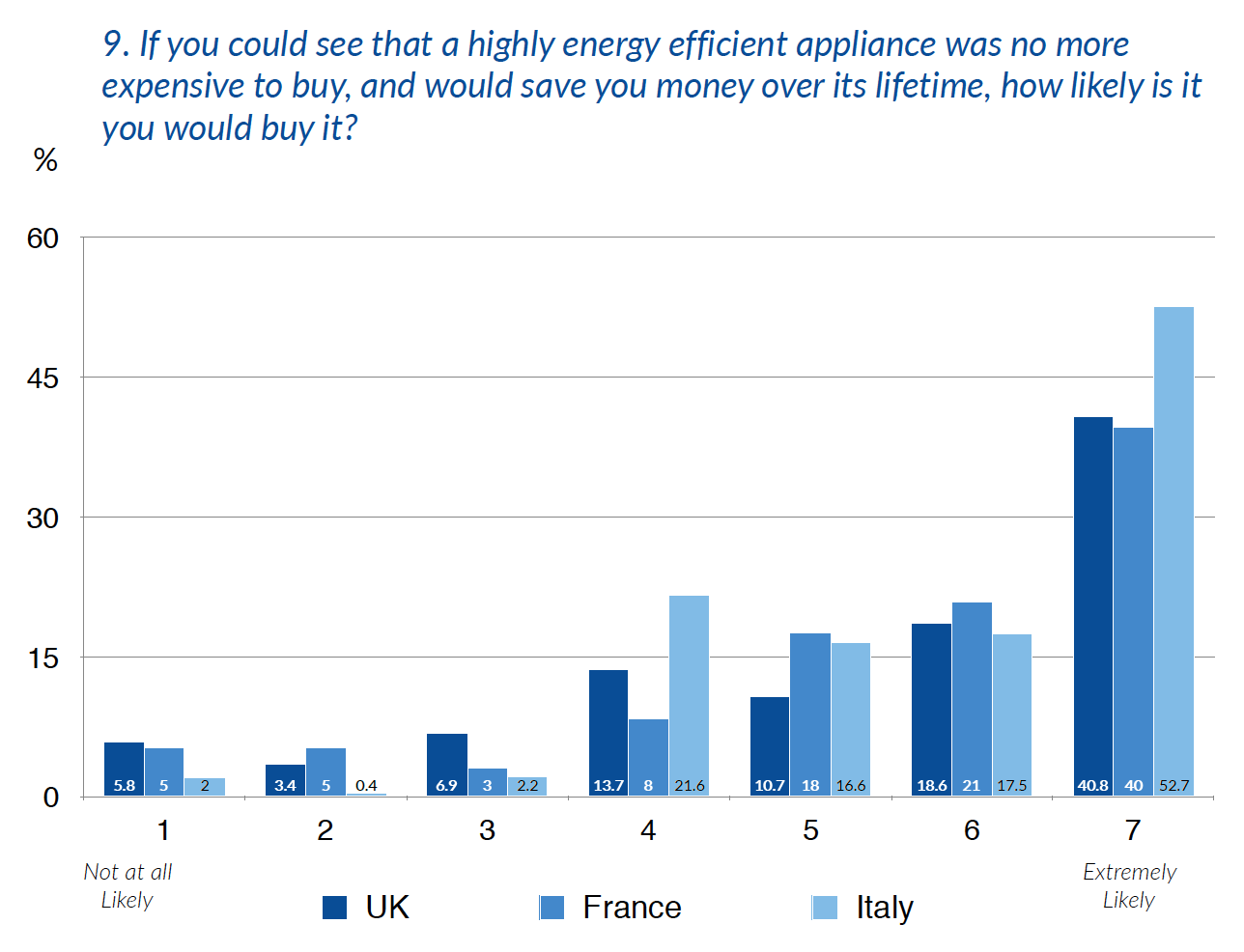Enervee monitors the entire online appliance market in France, the UK and the USA. And we’ve created a live tracker that allows us to determine the spread between the 90th percentile product — in terms of annual energy consumption — and the 10th percentile product offered for sale online each day. This spread is a conservative estimate of the energy savings potential among commercially available products that consumers are presented with when they shop online [1].

The data for October 31st, 2017 reveal the following:
- The French and UK markets show nearly identical characteristics across all categories, which is not surprising, given the common market, standards and testing procedures. The potential savings that can be achieved by purchasing the least consuming models (benchmarked to the 10th percentile model in terms of rated annual energy consumption) relative to the highest consuming (90th percentile model consumption) is within 6% across all six product categories when comparing the two markets.
Savings potentials in France and the UK range from a low of 28% for dishwashers to a high of roughly 80% for televisions.
- The annual energy consumption values for the US market cannot be directly compared with those for the European markets, due to differences in: (i) the metrics that are used to regulate minimum mandatory performance standards, (ii) energy consumption testing procedures and (iii) differences in technology. When data are normalized [2], the sales weighted average unit energy consumption of US dishwashers, for example, was found to be over 40% higher in 2010 than in European countries. Use of more water from a hot feed and powered drying are believed to be the main causes.
- Interestingly, the US dishwasher market had the smallest spread among 90th and 10th percentile consuming models — only 11% — despite 766 models available and a nearly 5-fold range in retail prices (between $340 and $1,499).
All other categories on the US market offer greater than 50% energy savings potential.
- In the case of clothes dryers, only a hand full of super-efficient heat pump dryer models have appeared on the US market to date [3], so are yet to be reflected in the 10th percentile benchmark. This means that the potential savings from best available technology on the US market (heat pump models with consumption below 200 kWh/y) are even greater than indicated in the chart above.
- With the exception of fridges and freezers, the appliances have roughly the same 90th percentile consumption across all markets. We can hypothesize that this convergence is due to increasing alignment between US and EU mandatory minimum standards. And in the case of electronics, such as televisions, models are essentially globally traded.
- As far as the cooling appliances are concerned, we Americans seem to like ours “XL”. The average refrigerator offered on the US market has a volume of 450 liters (16 cubic feet), 50% larger than the average in the two European markets — and in line with the 90th percentile model size available on the FR market. The 90th percentile US fridge model is nearly 730 liters (25.7 cubic feet). Mandatory standards have led to dramatically improved efficiencies, but there is still room for savings from better choices.
Among the 122 fridge models between 25 and 26 cubic feet, for example, $1000 can buy you a bottom freezer model with ice maker that consumes 620 kWh/y — or you can spend $14,000 on a high end side-by-side model that consumes 25% more.
Particularly for categories for which size or capacity is not strongly correlated with energy consumption (clothes washers, clothes dryers, dishwashers, televisions), these data give a high level indication of the still significant savings that can be achieved if consumers choose the most efficient products currently on the market. Almost half of all consumers in the UK and France believe it’s important to buy efficient (UK 42.1%, France 48.6%), and our consumer sentiment research shows that efficiency is an attribute that can seemingly compete with price — it’s no longer a third-tier, or nice-to-have feature.
There’s also strong support across European markets for buying energy efficient products if they’re shown to be fairly priced to begin with, with less than 10% of consumers across the markets unwilling to buy, and almost 2/3 willing to buy in this scenario.

Coupled with daily updated retail price information on each model, utility-branded consumer product marketplaces that provide shoppers with a relative energy efficiency score that makes efficiency visible at a glance can help consumers purchase better products that don’t cost more.
Notes
[1] This approach provides robust and conservative upper and lower market benchmarks, by essentially removing from consideration the “tail” of product models at the upper and lower ends of the market, which may include individual products that are unusual in some way. It reflects the choice set presented to consumers online each day, and is therefore not sales weighted.
[2] Refer to the Dishwashers Benchmarking Report published by the IEA Technology Collaboration Programme on Energy Efficient End-Use Equipment (IEA 4E).
[3] Consumer Reports’ Best Washer & Dryer Pairs — The Sequel

